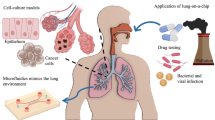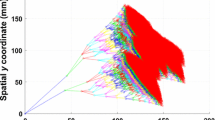Abstract
Microfabrication techniques are attractive for constructing artificial lungs due to the ability to create features similar in size to those in the natural lung. However, a simple and intuitive mathematical model capable of accurately predicting the gas exchange performance of microchannel artificial lungs does not currently exist. Such a model is critical to understanding and optimizing these devices. Here, we describe a simple, closed-form mathematical model for gas exchange in microchannel artificial lungs and qualify it through application to experimental data from several research groups. We utilize lumped parameters and several assumptions to obtain a closed-form set of equations that describe gas exchange. This work is intended to augment computational models by providing a more intuitive, albeit potentially less accurate, understanding of the operation and trade-offs inherent in microchannel artificial lung devices.





Similar content being viewed by others
References
J.C. Anderson, A.L. Babb, M.P. Hlastala, Modeling soluble gas exchange in the airways and alveoli. Ann. Biomed. Eng. 31(11), 1402–1422 (2003)
J.C. Anderson, M.P. Hlastala, Breath tests and airway gas exchange. Pulm. Pharmacol. Therapeut. 20, 112–117 (2007)
K.A. Burgess, H.H. Hu, W.R. Wagner, W.J. Federspiel, Towards microfabricated biohybrid artificial lung modules for chronic respiratory support. Biomed. Microdevices 11, 117–127 (2009)
W.J. Federspiel, K.A. Henchir, Lung, artificial: Basic principles and current applications, in Encyclopedia of Biomaterials and Biomedical Engineering, ed. by G.L. Bowlin, G. Wnek, 1st edn. (Marcel Dekker, New York, 2004), pp. 910–921
B. Florchinger, A. Philipp, A. Klose, M. Hilker, R. Kobuch, L. Rupprecht, A. Keyser, T. Puhler, S. Hirt, K. Wiebe, Pumpless extracorporeal lung assist: a 10-year institutional experience. Ann. Thorac. Surg. 86(2), 410 (2008)
S. Fischer, A.R. Simon, T. Welte, M.M. Hoeper, A. Meyer, R. Tessmann, B. Gohrbandt, J. Gottlieb, A. Haverich, M. Strueber, Bridge to lung transplantation with the novel pumpless interventional lung assist device NovaLung. J. Thorac. Cardiovasc. Surg. 131, 719–723 (2006)
G. Gros, W. Moll, The diffusion of carbon dioxide in erythrocytes and hemoglobin solutions. Pflügers Arch. 324, 249–266 (1971)
T.J. Hewitt, B.G. Hattler, W.J. Federspiel, A mathematical model of gas exchange in an intravenous membrane oxygenator. Ann. Biomed. Eng. 26, 166–178 (1998)
A.V. Hill, The possible effects of the aggregation of the molecules of haemoglobin on its dissociation curves. J. Physiol. 40, 4–7 (1910)
D.M. Hoganson, J.L. Anderson, E.F. Weinberg, E.J. Swart, B.K. Orrick, J.T. Borenstein, J.P. Vacanti, Branched vascular network architecture: a new approach to lung assist device technology. J. Thorac. Cardiovasc. Surg. 140(5), 990–995 (2010)
D.M. Hoganson, H.I. Pryor II, E.K. Bassett, I.D. Spool, J.P. Vacanti, Lung assist device technology with physiologic blood flow developed on a tissue engineered scaffold platform. Lab on a Chip (2011). doi:10.1039/c0lc00158a
T.-K. Hung, H.S. Borovetz, M.H. Weissman, Transport and flow phenomena in a microchannel membrane oxygenator. Ann. Biomed. Eng. 5, 343–361 (1977)
S. Kawahito, T. Maeda, T. Motomura, T. Takano, K. Nonaka, J. Linneweber, M. Mikami, S. Ichikawa, M. Kawamura, J. Glueck, K. Sato, Y. Nosé, Development of a new hollow fiber silicone membrane oxygenator: in vitro study. Artif. Organs 25(6), 494–498 (2001)
T. Kniazeva, J.C. Hsiao, J.L. Charest, J.T. Borenstein, A microfluidic respiratory assist device with high gas permeance for artificial lung applications. Biomed. Microdevices (2010). doi:10.1007/s10544-010-9495-1
T. Kniazeva, A.A. Epshteyn, J.C. Hsiao, E.S. Kim, V.B. Kolachalama, J.L. Charest, J.T. Borenstein, Performance and scaling effects in a multilayer microfluidic extracorporeal lung oxygenation device. Lab Chip 12, 1686–1695 (2012)
J.K. Lee, H.H. Kung, L.F. Mockros, Microchannel technologies for artificial lungs: (1) theory. ASAIO Journal 54, 372–382 (2008a)
J.K. Lee, M.C. Kung, H.H. Kung, L.F. Mockros, Microchannel technologies for artificial lungs: (3) open rectangular channels. ASAIO Journal 54, 390–395 (2008b)
G. Meschia, A. Hellegers, H. Prystowsky, W. Huckabee, J. Metcalfe, D.H. Barron, Oxygen dissociation curves of the bloods of adult and fetal sheep at high altitude. Exp. Physiol. 46, 156–160 (1961)
M. Mochizuki, H. Tazawa, M. Tamura, Mathematical formulation of CO2 dissociation curve and buffer line of human blood at rest. Jpn J Physiol. 32(2), 231–44 (1982)
M. Mochizuki, H. Takiwaki, T. Kagawa, H. Tazawa, Derivation of theoretical equations of the CO2 dissociation curve and the carbamate fraction in the Haldane effect. Jpn J Physiol. 33(4), 579–99 (1983)
J.T. Ottesen, M.S. Olufsen, J.K. Larsen, Applied Mathematical Models in Human Physiology, 1st edn. (Society for Industrial Mathematics, Philidelphia, 2004), pp. 155–190
G.J. Peek, M. Mugford, R. Tiruvoipati, A. Wilson, E. Allen, M.M. Thalanany, C.L. Hibbert, A. Truesdale, F. Clemens, N. Cooper, Efficacy and economic assessment of conventional ventilatory support versus extracorporeal membrane oxygenation for severe adult respiratory failure (CESAR): a multicentre randomised controlled trial. Lancet 374, 1351–1363 (2009)
J.A. Potkay, M. Magnetta, A. Vinson, B. Cmolik, Bio-inspired, efficient, artificial lung employing air as the ventilating gas. Lab on a Chip 11(17), 2901–2909 (2011)
S.N. Vaslef, R.W. Anderson, R.J. Leonard, Use of a mathematical model to predict oxygen transfer rates in hollow fiber membrane oxygenators. ASAIO J. 40, 990–996 (1994)
M.H. Weisman, T.-K. Hung, Numerical simulation of convective diffusion in blood flowing in a channel with a steady, three-dimensional velocity field. Am. Inst. Chem. Eng. J 17(1), 25–30 (1971)
M.H. Weissman, L.F. Mockros, Oxygen and carbon dioxide transfer membrane oxygenators. Med. Biol. Engng. 7, 169–184 (1969)
A. White, Principles of Biochemistry, 1st edn. (McGraw-Hill, 1978), pp. 960–962
World Health Organization (WHO), Chronic Respiratory Disease, (WHO Media Centre, 2011), http://www.who.int/mediacentre/factsheets/fs315/en/index.html. Accessed 13 Jan 2011.
Acknowledgments
We thank Dr. Ronald Triolo for facilities used to complete this work. This work was supported by Department of Veterans Affairs Rehabilitation Research and Development (VA RR&D) Grant F7404-R and VA RR&D Grant C3819C, The Advanced Platform Technology Research Center of Excellence.
Author information
Authors and Affiliations
Corresponding author
Rights and permissions
About this article
Cite this article
Potkay, J.A. A simple, closed-form, mathematical model for gas exchange in microchannel artificial lungs. Biomed Microdevices 15, 397–406 (2013). https://doi.org/10.1007/s10544-013-9736-1
Published:
Issue Date:
DOI: https://doi.org/10.1007/s10544-013-9736-1




